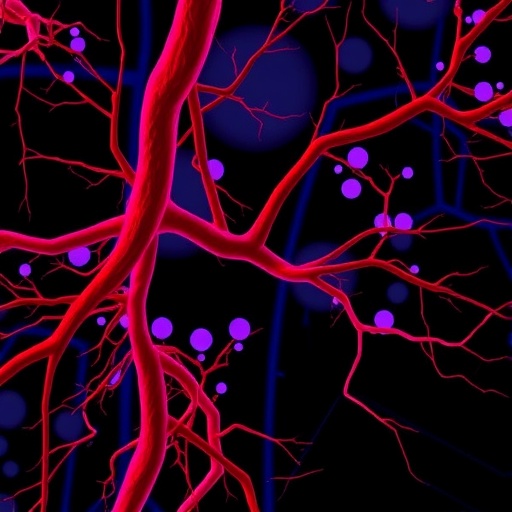Antiphospholipid syndrome (APS) represents a complex autoimmune disorder that affects approximately one in every 2,000 individuals worldwide. Known predominantly for its association with an elevated risk of serious thrombotic events such as deep vein thrombosis and stroke, APS’s clinical picture is further complicated by less recognized but equally damaging vascular effects. Among these, APS vasculopathy emerges as a critical yet understudied phenomenon, marked by structural abnormalities in microvascular blood vessels that severely compromise organ function over time.
APS vasculopathy affects between 10 to 20 percent of patients diagnosed with APS and involves a pathological inward proliferation of vascular cells. This atypical cellular growth causes a thickening of blood vessel walls, significantly narrowing the lumen—the central passageway through which blood flows. The constricted lumen impedes normal blood flow, setting the stage for ischemic injury to organs reliant on these small vessels, particularly the skin, kidneys, and heart. Ultimately, the progressive narrowing leads to tissue hypoxia, chronic organ damage, and in many cases, organ failure, highlighting a dire need for novel investigative and therapeutic strategies.
A breakthrough study spearheaded by Dr. Jason Knight, a prominent rheumatologist at the University of Michigan Health, pivoted the investigative lens toward the cellular intricacies underpinning APS vasculopathy. Employing state-of-the-art single-cell sequencing technology, Dr. Knight’s team embarked on an ambitious project to dissect the molecular signatures within the microvasculature of APS patients. By analyzing skin biopsies from individuals afflicted with severe APS, researchers were able to map out gene expression profiles at an unprecedented resolution, revealing key molecular players that orchestrate the pathological remodeling of blood vessels.
Among the most striking discoveries was the differential expression of two matricellular proteins from the CCN family—CCN1 and CCN2—within the endothelial and smooth muscle cells that construct the vessel walls. Traditionally, these proteins are implicated in fibrotic processes, mediating cellular communication pathways that promote scar tissue formation and chronic inflammation. In the context of APS, however, CCN1 and CCN2 seem to assume a different pathological role, driving aberrant proliferation and thickening of the microvascular architecture, thereby contributing directly to luminal occlusion and compromised microcirculation.
Delving deeper into the cellular mechanics, the study illuminated how the upregulation of CCN2 exerts a potent influence on vascular cell behavior. The overproduction of CCN2 activates signaling cascades, potentially including the Hippo pathway effector YAP1, which modulates cellular proliferation and matrix synthesis. This molecular axis appears central to the excessive growth of endothelial and smooth muscle cells within affected vessels, ultimately culminating in the hallmark features of APS vasculopathy. The precise modulation of these pathways, therefore, offers a promising target for therapeutic intervention aimed at halting or reversing vessel wall thickening.
The implications of this work extend beyond localized skin pathology. By replicating these findings in kidney tissue from APS patients, the research supports the concept that accessible skin biopsies may serve as a window into the broader systemic vascular complications of APS. This insight could revolutionize clinical monitoring, allowing for less invasive assessment of disease progression and efficacy of emerging treatments in combating microvascular damage.
Current treatment regimens for APS primarily focus on anticoagulation to prevent thrombosis but offer little in the way of addressing vasculopathic changes. The identification of CCN2 as a central mediator of APS vasculopathy paves the way for repurposing existing biologic drugs that target this protein. Some of these agents are already approved for fibrotic diseases, raising the possibility of accelerating their evaluation in APS clinical trials. However, substantial hurdles remain in engaging stakeholders and designing rigorous studies to establish efficacy and safety in this novel context.
In parallel to pursuing targeted biologics, Dr. Knight and colleagues are exploring alternative therapeutic avenues that may modulate CCN2-related signaling indirectly or mitigate its downstream effects. Such strategies could include small molecule inhibitors or approaches that focus on the regulation of YAP1 activity. The team envisions a multifaceted therapeutic pipeline, combining new drug candidates with optimized clinical trial designs informed by a deeper understanding of APS vasculopathy’s progression dynamics.
To this end, longitudinal research initiatives are underway, aiming to enroll over 100 patients with APS vasculopathy. These cohorts will be meticulously followed to capture the tempo of vascular changes and correlate molecular markers with clinical outcomes. This comprehensive approach is designed not only to identify robust biomarkers for early detection but also to refine patient stratification, allowing for personalized medicine approaches in a disease that has historically lacked targeted therapies.
Beyond the exciting potential for new treatments, this research marks a significant advancement in our comprehension of autoimmune-mediated vascular disease. By leveraging cutting-edge single-cell technologies and interdisciplinary collaboration spanning rheumatology, dermatology, nephrology, and molecular biology, the study exemplifies how integrative science can unlock the complexities of understudied conditions like APS vasculopathy.
As investigative efforts continue, the hope is that this foundational work will catalyze a renaissance in APS research, transforming it from a syndrome defined by its thrombotic risk to one with targeted interventions addressing its multifaceted vascular pathology. For patients, this could translate into enhanced quality of life, reduced organ damage, and ultimately, better survival outcomes.
In sum, the study led by Dr. Knight and colleagues heralds a new chapter in understanding APS, spotlighting CCN proteins as key molecular culprits in vasculopathy and offering a viable pathway toward innovative therapies. The convergence of advanced genomic technologies and translational research promises to reshape clinical management paradigms, stimulating hope for those grappling with the complications of this challenging autoimmune disorder.
Subject of Research: Antiphospholipid Syndrome Vasculopathy and molecular mechanisms involving CCN proteins.
Article Title: Microvascular Endothelial Cells License APS Vasculopathy Through YAP1- and CCN2-Mediated Signaling
News Publication Date: 29-Aug-2025
Web References:
https://www.ahajournals.org/doi/10.1161/CIRCULATIONAHA.125.073552
References:
“Microvascular Endothelial Cells License APS Vasculopathy Through YAP1- and CCN2-Mediated Signaling,” Circulation, DOI: 10.1161/CIRCULATIONAHA.125.073552
Keywords:
Cell biology, Laboratory procedures, Autoimmune disease, Antiphospholipid syndrome, Vasculopathy, CCN proteins, Endothelial cells, Smooth muscle cells, Fibrosis, Single-cell sequencing




